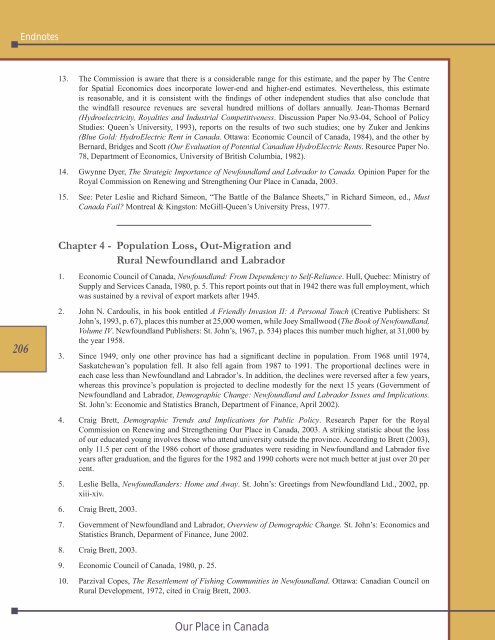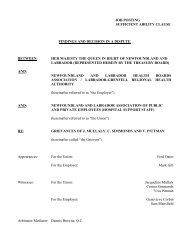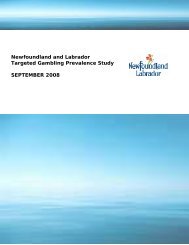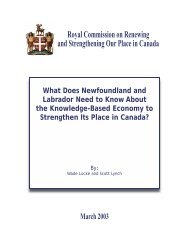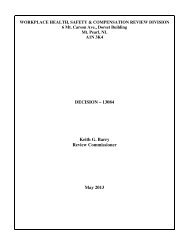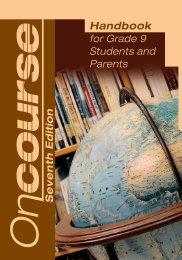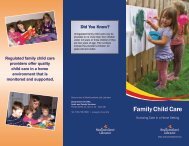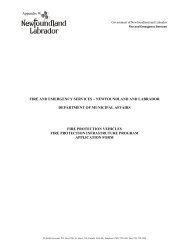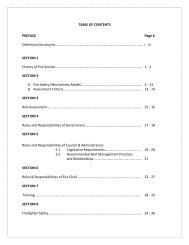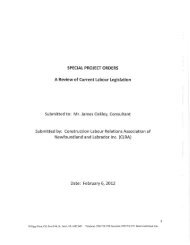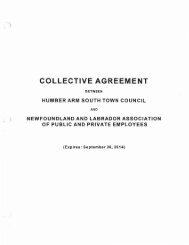Section 7 - Government of Newfoundland and Labrador
Section 7 - Government of Newfoundland and Labrador
Section 7 - Government of Newfoundland and Labrador
Create successful ePaper yourself
Turn your PDF publications into a flip-book with our unique Google optimized e-Paper software.
Endnotes<br />
13. The Commission is aware that there is a considerable range for this estimate, <strong>and</strong> the paper by The Centre<br />
for Spatial Economics does incorporate lower-end <strong>and</strong> higher-end estimates. Nevertheless, this estimate<br />
is reasonable, <strong>and</strong> it is consistent with the findings <strong>of</strong> other independent studies that also conclude that<br />
the windfall resource revenues are several hundred millions <strong>of</strong> dollars annually. Jean-Thomas Bernard<br />
(Hydroelectricity, Royalties <strong>and</strong> Industrial Competitiveness. Discussion Paper No.93-04, School <strong>of</strong> Policy<br />
Studies: Queen’s University, 1993), reports on the results <strong>of</strong> two such studies; one by Zuker <strong>and</strong> Jenkins<br />
(Blue Gold: HydroElectric Rent in Canada. Ottawa: Economic Council <strong>of</strong> Canada, 1984), <strong>and</strong> the other by<br />
Bernard, Bridges <strong>and</strong> Scott (Our Evaluation <strong>of</strong> Potential Canadian HydroElectric Rents. Resource Paper No.<br />
78, Department <strong>of</strong> Economics, University <strong>of</strong> British Columbia, 1982).<br />
14. Gwynne Dyer, The Strategic Importance <strong>of</strong> <strong>Newfoundl<strong>and</strong></strong> <strong>and</strong> <strong>Labrador</strong> to Canada. Opinion Paper for the<br />
Royal Commission on Renewing <strong>and</strong> Strengthening Our Place in Canada, 2003.<br />
15. See: Peter Leslie <strong>and</strong> Richard Simeon, “The Battle <strong>of</strong> the Balance Sheets,” in Richard Simeon, ed., Must<br />
Canada Fail? Montreal & Kingston: McGill-Queen’s University Press, 1977.<br />
206<br />
Chapter 4 - Population Loss, Out-Migration <strong>and</strong><br />
Rural <strong>Newfoundl<strong>and</strong></strong> <strong>and</strong> <strong>Labrador</strong><br />
1. Economic Council <strong>of</strong> Canada, <strong>Newfoundl<strong>and</strong></strong>: From Dependency to Self-Reliance. Hull, Quebec: Ministry <strong>of</strong><br />
Supply <strong>and</strong> Services Canada, 1980, p. 5. This report points out that in 1942 there was full employment, which<br />
was sustained by a revival <strong>of</strong> export markets after 1945.<br />
2. John N. Cardoulis, in his book entitled A Friendly Invasion II: A Personal Touch (Creative Publishers: St<br />
John’s, 1993, p. 67), places this number at 25,000 women, while Joey Smallwood (The Book <strong>of</strong> <strong>Newfoundl<strong>and</strong></strong>,<br />
Volume IV. <strong>Newfoundl<strong>and</strong></strong> Publishers: St. John’s, 1967, p. 534) places this number much higher, at 31,000 by<br />
the year 1958.<br />
3. Since 1949, only one other province has had a significant decline in population. From 1968 until 1974,<br />
Saskatchewan’s population fell. It also fell again from 1987 to 1991. The proportional declines were in<br />
each case less than <strong>Newfoundl<strong>and</strong></strong> <strong>and</strong> <strong>Labrador</strong>’s. In addition, the declines were reversed after a few years,<br />
whereas this province’s population is projected to decline modestly for the next 15 years (<strong>Government</strong> <strong>of</strong><br />
<strong>Newfoundl<strong>and</strong></strong> <strong>and</strong> <strong>Labrador</strong>, Demographic Change: <strong>Newfoundl<strong>and</strong></strong> <strong>and</strong> <strong>Labrador</strong> Issues <strong>and</strong> Implications.<br />
St. John’s: Economic <strong>and</strong> Statistics Branch, Department <strong>of</strong> Finance, April 2002).<br />
4. Craig Brett, Demographic Trends <strong>and</strong> Implications for Public Policy. Research Paper for the Royal<br />
Commission on Renewing <strong>and</strong> Strengthening Our Place in Canada, 2003. A striking statistic about the loss<br />
<strong>of</strong> our educated young involves those who attend university outside the province. According to Brett (2003),<br />
only 11.5 per cent <strong>of</strong> the 1986 cohort <strong>of</strong> those graduates were residing in <strong>Newfoundl<strong>and</strong></strong> <strong>and</strong> <strong>Labrador</strong> five<br />
years after graduation, <strong>and</strong> the figures for the 1982 <strong>and</strong> 1990 cohorts were not much better at just over 20 per<br />
cent.<br />
5. Leslie Bella, <strong>Newfoundl<strong>and</strong></strong>ers: Home <strong>and</strong> Away. St. John’s: Greetings from <strong>Newfoundl<strong>and</strong></strong> Ltd., 2002, pp.<br />
xiii-xiv.<br />
6. Craig Brett, 2003.<br />
7. <strong>Government</strong> <strong>of</strong> <strong>Newfoundl<strong>and</strong></strong> <strong>and</strong> <strong>Labrador</strong>, Overview <strong>of</strong> Demographic Change. St. John’s: Economics <strong>and</strong><br />
Statistics Branch, Deparment <strong>of</strong> Finance, June 2002.<br />
8. Craig Brett, 2003.<br />
9. Economic Council <strong>of</strong> Canada, 1980, p. 25.<br />
10. Parzival Copes, The Resettlement <strong>of</strong> Fishing Communities in <strong>Newfoundl<strong>and</strong></strong>. Ottawa: Canadian Council on<br />
Rural Development, 1972, cited in Craig Brett, 2003.<br />
Our Place in Canada


